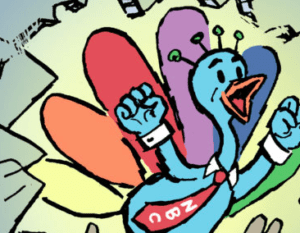 Here’s today’s AdExchanger.com news round-up… Want it by email? Sign-up here.
Here’s today’s AdExchanger.com news round-up… Want it by email? Sign-up here.
Cleaning House
The Trustworthy Accountability Group (TAG) is partnering with federal law enforcement to combat digital ad fraud. The aim is for TAG to work with the Department of Homeland Security, the FBI and the Justice Department to better understand ad fraud so those agencies are equipped to collect information and prosecute fraudsters. “Advertising is actually used as a delivery mechanism for much of the malware that then allows for identify theft and privacy concerns,” says TAG President and CEO Mike Zaneis. More at Beet.tv.
Ominous
Friday’s massive DDoS attack on DNS network Dyn was the first to use a botnet assembled from millions of internet-connected devices, primarily security cameras. The prospect of a new phase of security hacks disrupting internet services (and the ads they carry) is a scary one for pretty much every industry stakeholder. Who will protect us? “The Department of Homeland Security is supposed to provide the baseline of internet defense for the United States, but it is constantly playing catch-up,” writes The New York Times in its coverage of the internet outage. Cybersecurity researcher Daniel Krebs had just published a report with Dyn’s director of internet analysis, Doug Madory, on this exact kind of distributed attack, where a malicious device network overloads the internet host. More to come?
Lines In The Sand
The Financial Times ran a 30-day test asking ad-blocking users to whitelist the publisher in different ways. One subgroup was asked to whitelist the FT site but had the option to dismiss the notice and continue reading, and 40% chose to whitelist. Forty-seven percent of users whitelisted the site when shown an article with blocked text, and 69% of readers chose to whitelist when that was the only option to access content. The newspaper sees it as a win, with a good chunk of readers returning to monetization. More at Ad Age.
Spin Cycle
Everyone’s sick of the election … including US advertising agencies. CEO Michael Roth reported on Interpublic Group’s earnings call Friday that local media buys in some markets are “being crowded out by the election.” Omnicom CEO John Wren said on his earnings call last week that it’s a “very unusual year with the presidential election,” and some companies are waiting to adjust buys based on how Congress shakes out. Neither executives nor analysts see the slow quarter as cause for concern, since US budgets are expected to close the year bigly.
Live Video Uncertainty
Facebook will encourage use of Facebook Live via a big campaign with TV and OOH ads. The number of users broadcasting live videos has quadrupled since May, “but Facebook rarely advertises, and this kind of push makes me think Live is still not very popular overall,” writes Kurt Wagner at Recode. The ads were all created in-house and are hyperfunctional, giving explicit directions on how to begin broadcasting and use Live features. Platforms like Facebook, YouTube and Snapchat demonstrate the supply and demand for user-generated video, but live broadcasting specialists like Periscope and Meerkat haven’t hit critical mass. More.
But Wait, There’s More!
- US Growth Slows Across Ad Agency Networks – WSJ
- Facebook’s News Feed Will Adapt To Your Internet Speed – Engadget
- Google Quietly Drops Ban On Personally Identifiable Web Tracking – ProPublica
- Teads Ramps Up Vertical Video – release
- Print Advertising Woes Are Getting Worse – Poynter
- Microsoft, Ahead In The Cloud – NYT
- Resonate Integrates With YouTube For Social Video Product – release
- Privacy Groups Target Kids Advertising Disguised As YouTube Videos – CIO
- Why Newsrooms Are Expanding Their Data Teams – Digiday
- Search And Display Trends For Google, Facebook – release
- WPP’s Y&R Sets Up A New Global Health Care Practice – MediaPost











